Green
Mountain College
Poultney, VT
1948-1976
Introduction ~ Construction ~ Ski
Lessons ~ Grooming
Snowmaking ~ Racing ~ Memories ~
Current Photos
|
Introduction
Green Mountain College
operated a very small, but important ski area on campus from 1951 to
1979. This college area surprisingly was the site of many innovations
and quite unique facilities despite its small size. Nearly 5000 students
learned to ski area from the 1950's into the 1970's! Bill Jenkins, an
inventor and ski pioneer in Vermont, started this area.
The area evolved from the
first college area at the
Marcy Farm in Hampton,
NY, just outside Poultney. A rope tow served a wide slope there, but
there was a need to have something close to campus. Bill Jenkins closed
the Marcy Farm area and restarted a ski area on campus.
On this NELSAP page, Bill
will explain all of the details on the area far better than I can. But
before we get into the history and operation of this area, here are a
few highlights:
1. The area operated from
1951 to 1979, and was served at one point by three rope tows and a cable
lift - similar to a short poma (poma like seats on a low climbing
cable).
2. During the first few years, snow was trucked from around town and
spread out on the slopes.
3. In the 1950's, the area had one of the first snowmaking plants in the
country.
4. With a vertical drop of 31 feet, this was definitely one of the
smallest ski areas ever in the United States. The lifts were only 300
feet long!
5. Bill utilized "Turfskis" - which enabled ski lessons to begin in
September! Also, ski mats were used to allow skiing with no snow.
On the right is a picture of Bill Jenkins that appeared in a college
promotional brochure. Here he is explaining the Turfskis!
|
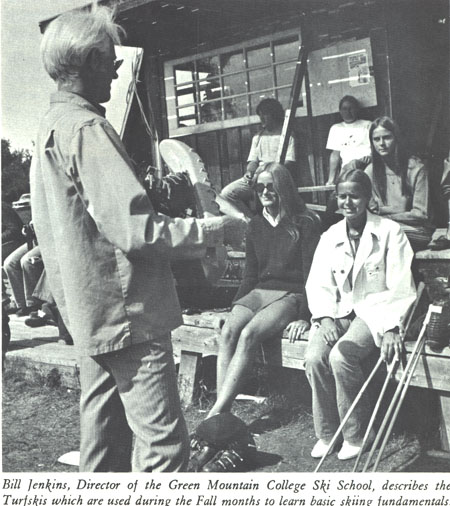 |
|
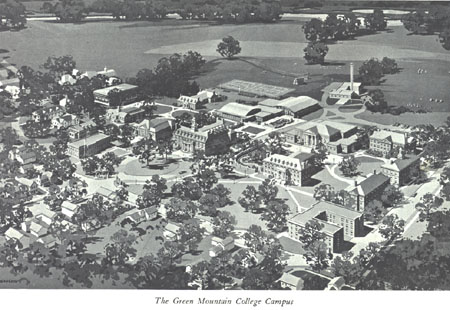 |
A promotional pamphlet
show the layout of the campus. The ski area is in the upper middle.
Click on the image for a larger version. |
| A promotional pamphlet from an early
year operation, 1951-1952. |
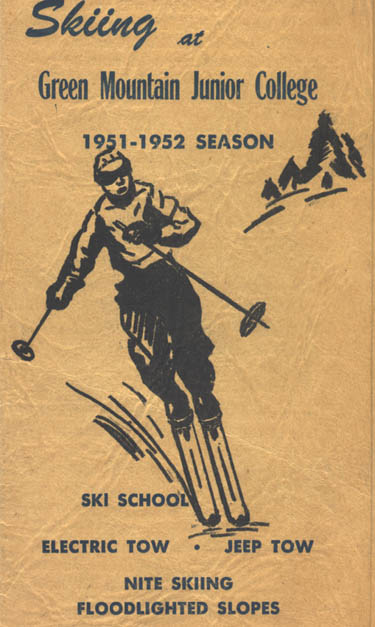 |
Note - the below sections, except
for the section on the area today, is written by Bill Jenkins. All historical
pictures are provided by him.
Constructing the Ski Area
|
At the
Marcy Farm area,
we had to transport the students a mile to that
location from the college (with their ski gear) for each hourly class.
It was chaos as you can imagine.
After a few years of this, I
excavated a nearby field and built three north facing slopes on the back campus
of the college. Each slope was a different gradient for beginners,
intermediate, and advanced skiers. Actually, by
building the slopes, we were able to produce just the right grades for
each level of student skier, and it was like a laboratory controlled
operation. The almost complete lack of fear factors really speeded
up the learning curve. The slopes, a minutes walk from the dorms, solved
the problems.
I built a 300 foot electric
powered rope tow which served all three slopes. Of some interest, because of my
concern that tow riders could be injured if the safety gate should malfunction I
designed an arm for the top terminal that had the return wheel on one end and a
counterweight on another.
This was pivoted in the middle so
that in the case of safety gate malfunction, the arm would tip down and the rope
would derail. Obviously, everything would come to a screeching halt, but it was
idiot proof, and worked just fine.
To the right is a view of
the area, in the early years of operation, likely close to 1950. Click
on it for the larger version.
|
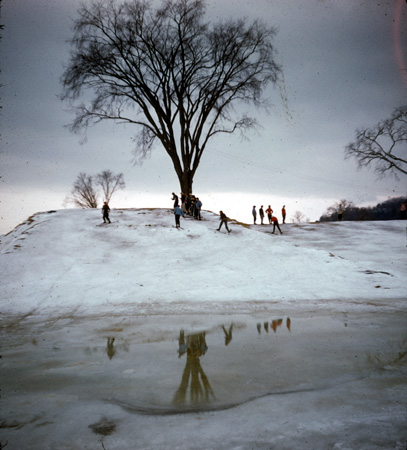 |
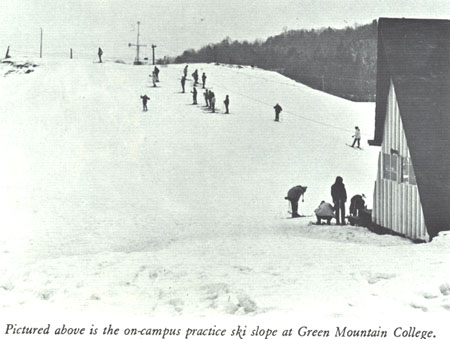
Vertical drop of the slope was an
astounding 31ft 6.75 inches! At one point, there were 3 tows, and later a cable
lift.
The offset cable lift was put in in the 60's, and it
basically was like the handle tow of today, although easier to ride.
However, for safety reasons, it became apparent that the cable levels
needed to be raised, which in turn led to the lifts at
Burrington Hill and the one in New Hampshire at Temple Mountain, then
eventually the Stabil lift design at Birdseye.
This design had very simple construction, and was really the ultimate in skier
safety and ease of riding.
At Green Mountain, I replaced the cable lift with the electric rope tow, which
solved the safety problem, and also eliminated cold weather
starting problems The tows were originally powered by Wisconsin gas engines.
Ironically, at this time, there were so many problems with T-bars and J-bars
that the resorts decided it was better to stick the customer up in the air on a
chairlift so that one was reasonably sure of getting to the top without falling
or being injured by a released T or J bar.
Here are various color views of the area, date
unknown. Click on each for larger version.
 |
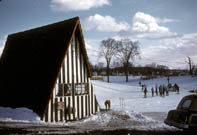 |
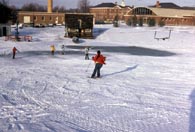 |
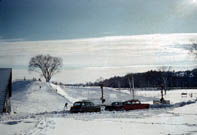 |
| The 31' 6.75" vertical
hill. |
Warming hut. |
Skiing down the slope.
College in background. |
Another view of the
slope. |
And some pictures of the various lifts. Click on
each for larger version.
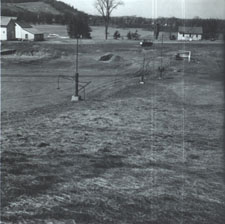 |
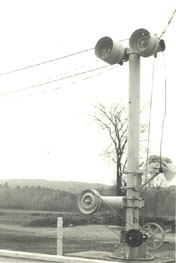 |
| Green
Mountain
offset cable lift. Cannot be derailed. |
Electric Rope Tow. |
Ski Lessons
|
On this diminutive
mountain, we taught 5000 students to ski.
Over 28 years of continuous
operation, the ski school grew to be the largest college ski school instruction
program in the country, reaching 350 students per season at its peak. Classes
were held for 4 days a week for 5 hours daily. The slope was lighted, and skiing
was available for 3 nights per week.
No college student ever suffered a
broken bone or serious injury, during the 28 year span, and this included the
racing teams, and weekend skiers at Pico.
I instituted a rigorous inspection
program to check release settings of bindings. I was one of the first to use
releasable bindings in a ski school operation, and it really paid off. I was
also the the first ski school to use fiberglass skis, the Holiday Model by K2.
I also had the students use short skis. Head height, or a bit longer. They would
be considered long today.
Although it would no doubt be
frowned on today, we taught all students to fall back, and on one side, on
command from any instructor. We explained that to them, until they became
experienced skiers, they could not properly evaluate when they were in danger of
losing control.
On the right is the cover
of promotional pamphlet, click on it for the larger version.
|
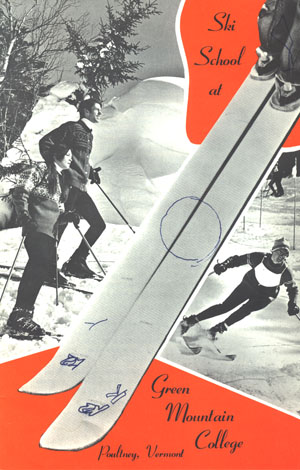 |
I also found a rather unique way
to have beginners safely learn to experience forward motion on skis, while
learning how to snowplow and snowplow turn. This eliminated the fear factor and
danger of getting out of control.
So that fear and gravity could not
take over, I rigged a wide boom on the rear of an Army surplus Jeep. Tow lines
were attached to the boom. On the college football field, we towed 8 skiers at a
time, round and round.
If a student had a problem, just
let go, and wait for the next jeep to come by. Never an embarrassing fall! This
worked very well as the jeep just creeped along at a very slow pace. The
instructor sat on the back of the jeep and gave instruction. Advancement was
exceptional, and very fast.
Various color pictures. - most
years unknown. Click on each for larger version.
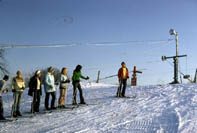 |
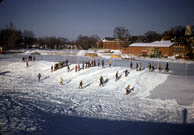 |
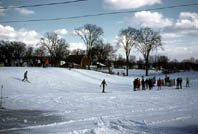 |
Skiers on the slope.
Rope tow in background. |
Skiers line
up for class at the bottom of the hill. |
A lesson. |
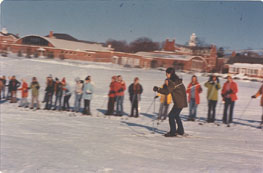 |
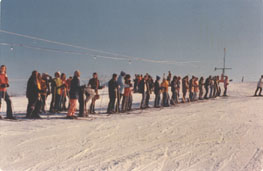 |
| 1971 class. |
Lesson on the slopes in
1971. |
More black and white pictures of
ski lessons. Click on each for larger version.
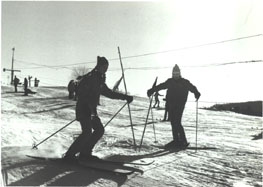 |
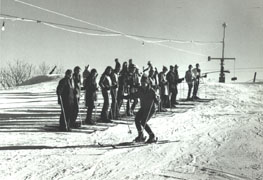 |
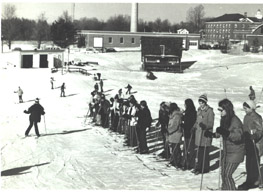 |
| Shows safety
wheel and tilt arm at top. |
Students on the slope. |
Ski class,
warming hut. Ski storage on left in sheds. Skijoring jeep for snow packing. |
As a college ski school operation,
I had the opportunity to use many innovations which came along. In early years
the operation started the first week in January, when plastic ski mats became
available, we started in September.
These worked quite well, and were
followed by Turfskis, similar to today's roller blades. These were excellent. By
the first day on snow, students could do parallel wide track ski turns on modest
grades. Then, they quickly became proficient on advanced slopes.
Here are plenty of fall ski
classes using turfskis and plastic mats! Click on each for larger version.
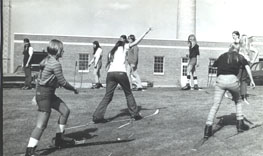 |
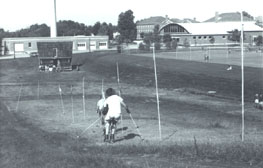 |
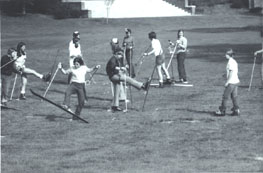 |
| Fall classes. |
Instructors
practicing slalom. Skier is not streaking, is wearing cut off jeans. Quite an
illusion! |
Beginners
learning basics on grass |
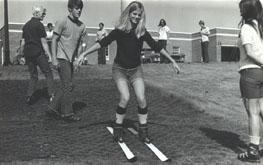 |
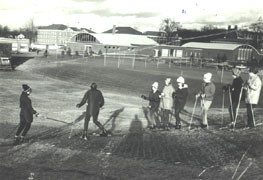 |
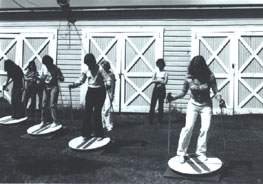 |
| Skier on a brush mat.
Bill Jenkins on far left. |
Fall ski classes on
brush mats |
Fall classes
on simulator, designed by Alois Mayer, ski school director Pico. Alois is also a
a famous producer of scenic postcards and calendars. |
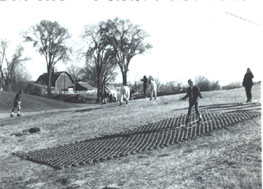 |
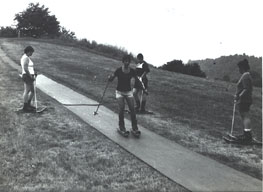 |
|
Beginner classes
on grass and mats.
Grass is soaped |
Summer ski
camp for weight loss group. Upside down Astroturf. Turf skis teach parallel
skiing. |
|
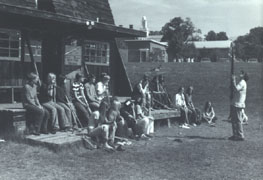 |
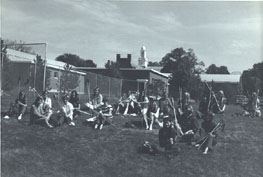 |
| Fall ski classes |
Fall - best
time for classes! |
Grooming
|
At Pico, Karl Acker and I, were
the first to do grooming (snow packing was the term), as far as I know. Using a
wide gauge Oliver Orchard Crawler, we outfitted it with 3ft long by 6 inch wide
elm slats, bolted to the tracks for flotation.
I did the same, at Green Mountain
College, to a John Deere bulldozer, which also served another purpose.
As Poultney is in the worst snow
belt of Vermont, lack of snow was always a problem. So after any snowstorm, the
village would load all the excess snow from the street plowing, and deposit it
at the base of our slope. Then I would push the snow up the slope with the
dozer. It was sometimes a bit sandy, but I often had depths of solid compacted
snow, five feet deep. It would last forever.
|
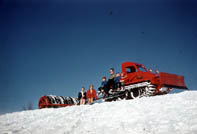
A groomer at the area.
Click on image for larger version. |
Later on, I did try grooming with a
large bombardier widetrack snowmobile. This worked fine, but trying to get it
started on cold nights was a pain. Then I went to a Bombardier J5 Crawler
tractor. And finally, I installed wide Terra-Tires on the Jeep, and it was
perfect for grooming my modest slopes.
After retiring in the middle 70's,
this led to me sell large, western farm tractors, modified with 66 inch high and
42 inch wide Terra Tires, to a number of resorts for year round use.
Then I designed a tractor, named
the Yak 500, specifically for ski resort grooming, and many other uses. All the
resorts are interested in the design, but no area will purchase, without seeing
a prototype. I have never found a backer, but am still looking.
Snowmaking
When
High Pond Mountain opened in Hubbardton, the owner, W. Douglas Burden, asked myself and Stan Whitney to
manage the ski school operation and the High Pond Inn. Our wives, Nancy and
Joan, joined in managing and operating the inn.
There, the first snowmaking system
in Vermont was installed, and the second in the world, I believe. I had a hands
on opportunity to learn about this exciting new discover.
Snowmaking became my salvation at
Green Mountain College. I installed the worlds' smallest snowmaking system. It
consisted of one Larchmont rotary unit, similar to lawn sprinkler, except that
it was much larger, and had an opening for a compressed air line, as well as the
water line.
To make it simple to move, and
keep it from being buried in the snow, I mounted the snow gun unit on a 20 foot
bom attached to the front of the same army jeep we used for skijoring classes.
My compressed air supply was 105
cubic foot air compressor mounted on a 2 wheel trailer. This was a standard
outfit used to operate jackhammers. I rented it from a construction equipment
supplier.
During snowmaking operations, I
towed the compressor behind the jeep. By a great stroke of luck, I didn't need a
water pump. At night, there was little demand for water at the college. our
water supply was an artesian well which had unlimeted water available at 120lbs.
This was more than enough pressure for snowmaking.
Consequently, I hooked up 500ft of
black plastic water pipe to the maintenance building water outlet and this, with
the compressor hose, was draped up over the compressor, jeep, and out to the
snowgun on the end of the boom.
It was really a weird looking
outfit, but it worked well. On a good cold night, i could cover the acre and
half slope with six inches of snow.
In those days, freeze ups of water
and compressor hoses were routine. Again, I was fortunate. Nearby to our ski
slope was the college heating plant. On the ground floor, there was a large open
area with a cement floor that was warm because of the boilers beneath. If I got
a freeze up, I dragged the hoses into this space, waited an hour, then blew them
clear with compressed air.
I soon found that the boom had
another unexpected advantage. Because of its raised height, about 15ft or so,
the amount of snow made was substantially increased, without additional costs.
It gives me a chuckle, 50 years later, to see the latest snowmaking advancement
are tower guns.
As you can imagine, making snow in
Vermont in the early fifties was grounds for getting certified as a lunatic.
However, as no other resorts had snowmaking, I was often the first to open my
tiny, teeny slope.
Racing
|
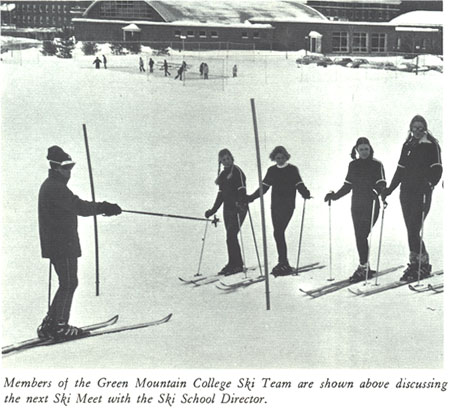 |
The
years went by, and I started a racing team at the college. Imagine running 10
gates at a time, on a 31ft vertical, 300' long hill, to practice racing against
Dartmouth, UVM, Middlebury, UNH, Syracuse, Cornell, and others. Fortunately, we
did have excellence cross country skiing trailes through the college fields and
the nearby hills.
We used to kid the other teams
that if wasn't for Green Mountain College, one of them would have to come in
last.
Our crowning achievement was some
years later, when the big college teams were moved up and we competed against U
Maine, Colby, Williams, Bates, etc. We actually won the Bates Winter Carnival
one year, and we were the only two year college competing.
|
Readers Memories:
Steve Anderson: I
grew up in Poultney from 1961 thru 1976 and remember skiing there in the
early 70's. It wasn't much but it was enough to keep the 700 girls there
busy when they couldn't get to Pico or Killington. I forget if it had a
rope tow or Platter pull. It was just one tiny open hill behind the tennis
courts and the Library. In the summers they would use the hill for
Bluegrass concerts and festivals as it made a great outdoor arena with its
gentle slope.
Ski Area Today
|
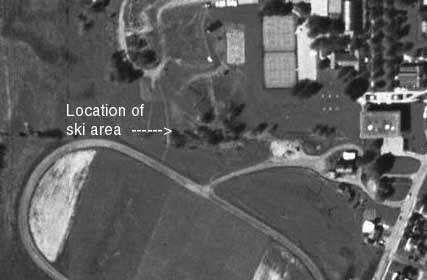
|
Here is the site of the
area in the late 1990's - note how its hard to pick out any details of
the area. |
| I visited this area in
May, 2003. The hill still exists for the most part, and has been used as
an amphitheater for outdoor events at the college. There is little that
would identify this as a former ski area.
To the right are two pictures of the
slope. Click on each for the larger version. |
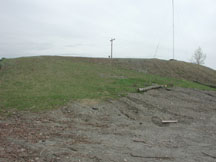
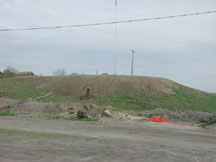 |
|
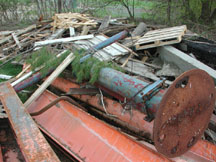
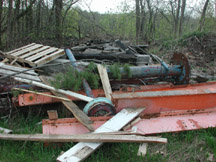
|
However, I poked around to
the right of the hill and found a small dumping grounds, and lo and
behold, there were parts of the old lift there! You can see the towers
in the pile. Click on each for the larger version. |
If you remember
this area and have more info just let us know.
Last updated: October 21, 2006
Head
back to Lost VT Ski Areas
Head
back to the Main Page




































